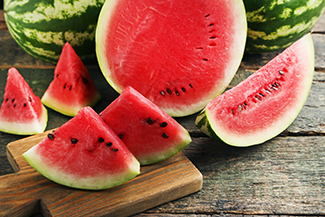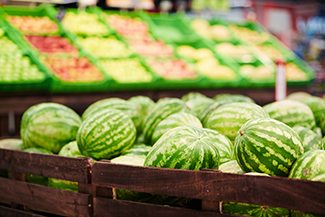Farm Fresh Arizona Watermelons
Juicy-Sweet Watermelon Is The Perfect Summertime Treat
With the summer heat bearing down on us, it's refreshing to have a cool, light snack: the beloved watermelon! As usual, there is always lots to learn when it comes to our favorite foods so we here at Rosie on the House turn to one of the experts, Julie Murphree with the Arizona Farm Bureau and FillYourPlate.org to educate us on what is possibly the most refreshing fruit of all:
When you next enjoy this juicy-sweet summertime treat, keep some of these interesting facts in mind!
History
 Watermelon is believed to originally come from the Kalahari Desert in Africa . The first documented watermelon harvest was in ancient Egypt around 5,000 years ago. It is shown in hieroglyphics on the walls of ancient Egyptian buildings. Watermelon seeds were even found in the tomb of the Pharaoh Tutankhamun. As advancements in travel abilities progressed, watermelons began to spread along the Mediterranean Sea via merchant ships. Watermelon reached China, which is the largest producer of watermelons today, by the 10th century. By the 13th century it began to spread through Europe by way of the Moors. John Egerton, a Southern food historian , believes it was African slaves who introduced watermelon to the United States.
Watermelon is believed to originally come from the Kalahari Desert in Africa . The first documented watermelon harvest was in ancient Egypt around 5,000 years ago. It is shown in hieroglyphics on the walls of ancient Egyptian buildings. Watermelon seeds were even found in the tomb of the Pharaoh Tutankhamun. As advancements in travel abilities progressed, watermelons began to spread along the Mediterranean Sea via merchant ships. Watermelon reached China, which is the largest producer of watermelons today, by the 10th century. By the 13th century it began to spread through Europe by way of the Moors. John Egerton, a Southern food historian , believes it was African slaves who introduced watermelon to the United States.
Arizona Watermelons
Today Arizona produces around 5.9% of the U.S. watermelons. Arizona is the 5th highest U.S. producer of watermelons, coming in behind Georgia, Florida, Texas, and California. Watermelons are grown in Maricopa, Yuma, La Paz, Cochise and Pinal Counties. Maricopa, Yuma, and Pinal, typically account for the majority of the crop grown. Watermelon are usually planted in January in Arizona and as watermelon takes around 90 days to grow from seed to harvest, they typically begin to be ready by May. Our watermelon is at its peak in June and July, but is usually available until November. The majority of Arizona’s watermelon is sold domestically.
Refreshing and Healthy
Watermelon is perhaps the most refreshing fruit of all. It is 92% water, so consuming it in the hot summer months is a great way to make sure you are staying hydrated. Apart from being the perfect thirst quencher, watermelon hosts a variety of health benefits. In fact, fresh watermelon has earned the American Heart Association’s “Heart-Check Mark” for being a heart healthy food. Here is a closer look at some of the benefits to including watermelon in your diet:
-
-
- If you are trying to control your weight, watermelon is the perfect food to include in your diet. One cup of watermelon has around 40 calories and has the most nutrition per calorie of common foods.
- Watermelon contains dietary fiber which promotes digestive health.
- It contains an antioxidant carotenoid called lycopene. According to Watermelon.org and the Western Watermelon Association, studies have shown that lycopene has a potential role in reducing risk various cancers (such as breast, prostate, and endometrial cancers) and heart disease. It can also provide protection to skin from harmful UV rays. Watermelon contains higher levels of lycopene than any other fruit or vegetable.
- Both vitamins B6 (pyridoxine) and B1 (thiamin) are found in watermelon, which aid in metabolism and nervous system function.
- Watermelon seeds are an excellent source of magnesium. Magnesium is required for maintaining a healthy heart rhythm and building strong bones. It is also important in keeping a healthy immune system and maintaining normal nerve and muscle function.
- Citrulline is and amino acid that is found in watermelon. Our bodies turn it into another amino acid called arginine. Arginine aids in cell division and the healing of wounds. It also aids in blood flow which supports cardiovascular function.
- Potassium is also found in watermelon. Potassium helps maintain a healthy blood pressure.
- Watermelon also has vitamins A and C, so it is an optimal food for maintaining healthy vision and boosting the immune system. Two cups of watermelon contains 25% of your recommended daily vitamin A and 30% of your vitamin C.
-
Choosing The Best Watermelon
 It is apparent that enjoying this succulent food as a part of your diet has many health benefits, but how do you choose the right one when making a purchase?
It is apparent that enjoying this succulent food as a part of your diet has many health benefits, but how do you choose the right one when making a purchase?
We found these tips from the Old Farmer’s Almanac:
-
-
- If you thump or flick it and it sounds hollow, that typically means it is ripe.
- Look at the bottom of the watermelon . A ripe watermelon will have a cream or yellow colored bottom. The bottom will be white if not ripe.
- Look at the color on top of the watermelon. If it is ripe there is little contrast between the stripes.
- It should be symmetrical and firm. You want it to be free of cuts, dents and bruises.
-
Watermelon Storage
After you get your watermelon home, a whole uncut watermelon will typically last 7-10 days on the counter. When refrigerated it can possibly last 2-3 weeks. When cut watermelon can last in the fridge for around 3-5 days. Your cut watermelon should be stored in an airtight container. Unfortunately watermelons don’t freeze well. The flesh becomes a dark red and when cut open the juices will flow out leaving you with an empty rind.
Let's Eat Watermelon!
Watermelon is a versatile food. It is most commonly eaten raw cubed, sliced or balled, but it can also be enjoyed cooked and added to a variety of dishes. You can actually eat the entire watermelon! The seeds and rinds are both edible and offer their own nutritional benefits. In China the rind is often used in stews and stir-fries and it is also eaten pickled. Pickled rind is also popular in Russia and parts of southern U.S.
Fill Your Plate Recipe:
Give one of our favorite recipes a try.
-
-
- 1 5-pound Watermelon
- 1/2 Red Onion
- 1/4 Cup Red Wine Vinegar
- 1/2 Cup Olive Oil
- 8 Ounce Crumbled Cheese, Blue or Feta
-
Directions
Alternatives: Substitute 1/4 cup of lime juice and 1/4 cup of lemon juice for red wine vinegar. Add 1/4 cup basil. Cube mozzarella cheese as replacement for the Feta or Blue cheese. Use pine nuts for extra texture. Cut watermelon from rind into bit-sized pieces. Thinly slice the red onion. Mix Red wine vinegar and olive oil together and mix in with the watermelon cubes and cheese. Salt and pepper to taste.
Watermelon is a healthy food craved by kids, teens, and adults alike, and it is easy to see why it is a star of the produce department. Head to your local grocery or farmers market and purchase some of this sweet treat to enjoy today!
PODCAST
Julie Murphree of the Arizona Farm Bureau and Charlie Montgomery of Rousseau Farming Company talk about growing the millions of pounds of watermelon produced, the hundreds of varieties, and the story behind seedless watermelons. Arizona is one of three states that grow and ship plenty of this summertime treat. #ArizonaMelons
Arizona produces its share of watermelons and other melons for summer eating. Kami Weddle is the Director of Food Safety And Quality for Rousseau Farming Company. She discusses the process of growing melons, leafy greens and other vegetables from the farm to your table. Joined by the Arizona Farm Bureau's Julie Murphree.
Farm Fresh: #Watermelon #Melons #ArizonaMelons
###
